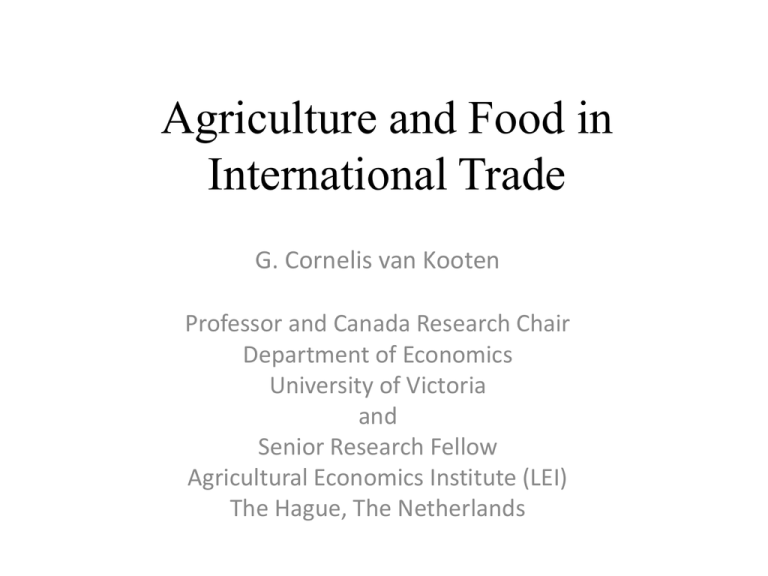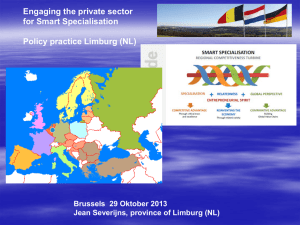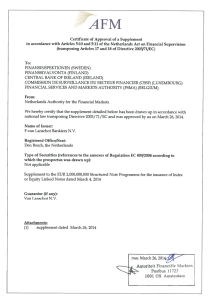US Farm Bill - University of Victoria
advertisement

Agriculture and Food in International Trade G. Cornelis van Kooten Professor and Canada Research Chair Department of Economics University of Victoria and Senior Research Fellow Agricultural Economics Institute (LEI) The Hague, The Netherlands Agriculture and World Trade Organization (WTO) Negotiations • Agricultural programs are an obstacle to concluding trade deals (e.g., completion of WTO’s Doha Round) • In 2012, state support for agriculture accounted for: – – – – – 5.7% of farm income in Brazil 12% of farm income in America 26% of farm income across the OECD 29% of farm income in the European Union 15% of farm income in Canada (2010-2012 average) Why liberalize? Estimates of global welfare gains of removing global agricultural trade distortions ($US billions) Study IMF and World Bank, 2002 World Bank, 2002, static scenario World Bank, 2002, dynamic scenario USDA/ERS, 2000, static scenario USDA/ERS, 2000, dynamic scenario Anderson, 1999 Francois en LEI, 2002 as % of Total world GDP 128 0.4 248 0.8 587 1.9 31 0.1 56 0.2 165 0.5 109 0.4 Source: Kuyvenhoven, A. & H. Stolwijk, 2011. Developing Countries and EU Agricultural and Food Policy. Chap 5 in EU Policy for Agriculture, Food and Rural Areas (pp. 121-138) edited by A. Oskam, G. Meester & H. Silvis. Wageningnen, NL: Wageningen Academic Publishers. p.129 WTO Agricultural Boxes • In WTO terminology, subsidies in general are identified by ‘boxes’ that are given the colours of traffic lights: – green (permitted) – amber (slow down — i.e. reduce) – red (forbidden). • In agriculture, things are more complicated. In the Agriculture Agreement: – There is NO red box – Amber box: domestic supports that exceed reduction commitment levels; any measures that distort production and trade – Blue box: subsidies that are tied to programs that limit production (e.g., supply-restricting marketing boards) – Green box: acceptable (supposedly non-trade distorting) policy – S&D box: exemptions for developing countries. Amber Box • All domestic support measures considered to distort production and trade (with some exceptions) fall into the amber box, which is defined (Article 6 of the Agriculture Agreement) as all domestic supports except those in the blue and green boxes. These include measures to support prices or subsidies directly related to production quantities. • These supports are subject to limits: ‘de minimis’ (minimal) supports are allowed (5% of agricultural production for developed countries, 10% for developing countries); the 30 WTO members that had larger subsidies than the de minimis levels at the beginning of the post-Uruguay Round reform period are committed to reduce these subsidies. Blue Box • Created in 1995 • This is the ‘amber box with conditions’ – conditions designed to reduce distortions. Any support that would normally be in the amber box is placed in the blue box if the support also requires farmers to limit production (see Paragraph 5 of Article 6 of the Agriculture Agreement). – Set aside programs/cross compliance – Supply management (?) • At present there are no limits on spending on blue box subsidies. In the current negotiations, some countries want to keep the blue box as it is because they see it as a crucial means of moving away from distorting amber box subsidies without causing too much hardship. Green Box • Defined in Annex 2 of the Agriculture Agreement • To qualify, green box subsidies must not distort trade, or at most cause minimal distortion (paragraph 1). They have to be government-funded (not by charging consumers higher prices) and must not involve price support. • Tend to be programs not targeted at particular products, and include direct income supports for farmers not related to (i.e., decoupled from) current production levels or prices. • Include environmental protection and regional development programs. “Green box” subsidies are therefore allowed without limits, but comply with other criteria in Annex 2. Green Box: Summary To be eligible to be categorized as “green box”, a support measure must meet two basic criteria: 1. The support must be government funded 2. The support must not have the effect of providing price support to producers as price support is viewed as distorting production and trade • Example: Safety Nets such as Single Farm Payment, Whole Farm Insurance Green Box Criteria: Safety Nets Specific criteria apply for safety nets: i. Eligibility for such payments shall be determined by an income loss that exceeds 30% of some reference level (moving 5-year Olympic average or moving 3-year average). ii. Payments shall compensate for ≤70% of the producer’s loss. (If threshold of 85% is used, as in Canada’s Growing Forward program, difference would be assigned to blue box) iii. Payments shall relate solely to income; it shall not relate to the type or volume of production This is the main reason why countries have turned to crop insurance, particularly whole farm insurance. Question: Does whole farm insurance distort production? Canada – European Union Comprehensive Economic and Trade Agreement (CETA) • Elimination of tariff and non-tariff barriers could increase Canadian agri-food exports from $2.7 billion to $3.2 billion in the long run • Average Canadian duty on agricultural products: 21.9% – Average duty on non-agricultural commodities: 3.5% – Average duty on imports of supply-managed products (milk, chicken, eggs, turkeys): 159.1% but over 200% at margin • EU imposes high duties on beef (142%), pork (32% – 70%), fruits &vegetables (31.8%), fish & seafood (12.5%), and wheat & oats. – EU favors durum production in its CAP subsidies – Average duties on non-agricultural commodities: 2.2%. Canada’s Agri-food Trade Balance with the European Union, 2001–2010 Source: http://www.parl.gc.ca/content/lop/researchpublications/cei-25-e.htm?Param=ce5 CETA: European issues of sensitivity • Genetically modified organisms (GMOs) • Fish & seafood: imports from Canada could threaten European industry • Sectors with high duties: – beef & pork products – Grains – processed foods These are export markets that Canada hopes to develop. • EU wants Canada to recognize ‘geographical indications’: – A ‘geographical indication’ refers to named region and is used to describe a local agricultural or food product or manufacturing process from that region. – Recognition of ‘geographical indications’ could result in loss of market share by Canadian food industry exporters. CETA: Canada’s Sensitive Issues • Canada wants to protect its supply managed industries, using prohibitive tariffs for amounts exceeding the tariffrate quota (TRQ). – Under CETA slightly more quota is allocated to the EU (e.g., TRQ on cheese raised by 16,000 tons) – Negotiations to reduce the tariff applied on quota • Canada wants clarity on ‘rules of origin’ for agri-food, especially livestock because: – North American market is highly integrated – EU rules would require modification of the traceability system now in place. CETA: Non-tariff Barriers • European issues: – length of Canada’s process for approving new veterinary drugs – delays in processing applications for authorization of food additives – Canadian standards on the composition of cheeses • Canadian issues: – European regulations on beef, including ban on growth hormones – delays in approval process for genetically modified organisms (GMOs) – GMO traceability and labelling requirements Agricultural Programs and Subsidies • Agricultural subsidies and farm programs are an obstacle to free trade, both with regards to CETA and WTO • Slow convergence of programs through the WTO process mentioned earlier European Policy • After WWII, it was easy to establish an agricultural policy regime that provided farmers with large subsidies – Experience with shortages during and shortly after WWII – Large rural population with political clout • Program continued despite large costs to consumers and/or taxpayers and declining farm population – Rent seeking: fewer farmers with more to gain have greater incentive to lobby politicians – Consumers/taxpayers are less concerned with costs of farm programs as proportion of income spent on food declines – Consumers increasingly concerned with food safety (e.g., BSE crisis, pig flu, hoof & mouth disease, etc.): Rationale for continued government support of food and agriculture European Policy: Issues with CAP 1. From beginning of CAP: High and increasing costs – – – – Growing stocks of wine, butter, etc. Growing international resentment of export subsidies Need to reform CAP to facilitate trade negotiations Desire to have budget to pursue objectives other than agriculture European Policy: Issues with CAP (cont) 2. Beginning 2004, integrating new Central and Eastern European members into the EU – Very expensive proposition: 10-year program to get to full benefits – June, 2013 CAP reforms and convergence of payments: • between EU-15 (average payment: €295/ha) and new members (€187/ha) • between countries (e.g., average Dutch payment : €440/ha) Dutch De-coupled Payment based on Historic 2000-2002 Yields Crop wheat barley seed potato edible potato starch potato sugar beet onions Source: Boere and van Kooten (2014) Payment (€/ha) 377.5 377.5 0 0 1,043.1 687 0 European Union Budget, 2014 Security & citizenship Environment & 1.5% Climate 0.3% Maritime & Fisheries Fund (EMFF) 0.7% Agricultural Fund for Rural Development (EAFRD) 9.8% Agricultural Guarantee Fund (EAGF) 30.7% Global Europe 5.8% Administration & Misc. 6.3% Smart & inclusive growth 44.9% TOTAL = € 142,649.5 million European Policy: Issues with CAP 3. Environmental concerns – Shift of lands out of forestry into agriculture unless prohibited by other laws – Soil depletion – Chemical pollution from agriculture AC-10: Slovenia, Slovakia, Poland, Hungary, Malta, Czech Rep, Cyprus, Lithuania, Latvia, Estonia AC-Next: Romania, Bulgaria Chemical Use, kg per cultivated ha, 2000 200 180 160 140 120 100 80 60 40 20 0 A C - 10 EU - 15 EU - 25 A C - N ext Turkey N . A merica U.S. 103 kg/ha; Canada 54 kg/ha Is Canada Falling Behind? Who Needs CETA Most? A Tale of Two Countries • Canada thinks of itself as a large exporter of agricultural commodities but we are outdone by the Netherlands. – Many years the Netherlands is the largest exporter of agricultural products by value after the United States • Let’s look at some statistics and see what Canada might aspire to: Rank 1 2 3 4 5 6 7 8 9 10 11 12 13 14 15 16 17 18 19 20 Commodity Mt Flag $ billions $/tonne Wheat 148.27 1 46.85 316 Food Prep Nes 12.29 16 46.72 3,800 Soybeans 91.02 3 45.03 495 Palm oil 37.05 5 40.57 1,095 Rubber 7.50 26 33.89 4,520 Maize 109.65 2 33.73 308 Wine 10.39 19 32.11 3,090 Bever. Dist.Alc 4.22 56 27.34 6,485 Coffee, green 6.72 33 27.15 4,037 Beef&Veal 4.98 49 26.72 5,368 Cheese 5.22 46 26.46 5,068 Soybean cake 64.91 4 25.40 391 Chocolate 4.85 50 22.98 4,739 Pastry 7.15 29 22.73 3,177 Chicken meat 12.47 15 22.07 1,770 Cotton lint 8.20 25 20.85 2,543 Cigarettes 1.12 133 20.70 18,468 Sugar Raw 31.97 6 18.50 579 Sugar Refined 23.11 8 17.36 751 Pork 5.23 45 16.63 3,181 Top Twenty Agricultural Commodity Exports, Global, 2011 (Ranked by value) Source: FAO Rank 1 2 3 4 5 6 7 8 9 10 11 12 13 14 15 16 17 18 19 20 Country USA Malaysia Indonesia Brazil USA Indonesia Brazil USA Thailand France Argentina USA UK Brazil Brazil France Italy Canada Australia Brazil Commodity Soybeans Palm oil Palm oil Soybeans Maize Rubber Sugar Raw Wheat Rubber Nat Dry Wine Soybean cake Cotton lint Bever. Dist.Alc Coffee, green Chicken meat Wheat Wine Wheat Wheat Cake of Soybeans Value ($’000s) $17,563,868 $17,452,177 $17,261,248 $16,327,287 $13,982,404 $11,735,105 $11,548,786 $11,134,659 $10,634,724 $9,941,495 $9,906,725 $8,425,179 $8,330,057 $8,000,416 $7,063,214 $6,738,299 $6,075,404 $5,742,111 $5,709,036 $5,697,860 Major Commodity Exporters, 2011 Source: FAO Ranking of Exports of Food Prep Nes by Country, 2011 Rank Country 1 2 3 4 5 6 7 8 9 10 Germany Netherlands China Italy France Thailand UK Belgium Denmark Canada 9 mil tonnes $ ×10 1,024.25 917.85 1,317.13 777.50 526.55 770.45 322.14 462.09 295.43 448.95 4.060 3.528 2.580 2.470 2.261 1.632 1.572 1.506 1.444 1.397 $/tonne 3,963 3,843 1,959 3,177 4,293 2,118 4,881 3,260 4,889 3,112 Food prep nes: Includes both crop and livestock products: homogenized composite food preparations; soups and broths; ketchup and other sauces; mixed condiments and seasonings; vinegar; yeast and baking powder; stuffed pasta; couscous; and protein concentrates. Comparison of Cereal Grain Production, 2011 Rank Country Barley 7 Canada 17 Netherlands Maize 11 Canada Oats 1 Canada 12 Netherlands Rapeseed/Canola 1 Canada 14 Netherlands Rye 2 Canada 13 Netherlands Soybeans 5 Canada 8 Netherlands Wheat 3 Canada mil tonnes $ millions $/tonne 1.055 0.274 313.6 77.9 297 284 1.070 359.6 336 1.658 0.029 429.8 10.2 259 351 7.891 0.180 4645.0 123.7 589 688 0.200 0.018 57.8 3.6 289 204 2.651 0.738 1445.8 405.9 545 550 16.335 5742.1 352 Comparison of Other Crop Production, 2011 Rank Country Potatoes 1 Netherlands 5 Canada Lettuce and Chicory 4 Netherlands 11 Canada Spinach 4 Netherlands 11 Canada Sugar Beets 2 Canada 4 Netherlands millions tonnes $ millions $/tonne 1,942.4 614.1 1,007.5 229.5 519 374 118.5 24.0 165.8 24.4 1399 1017 20.2 1.2 12.7 2.7 631 2352 194.3 265.0 22.0 13.0 113 49 Comparison of Meat and Dairy Production, 2011 Rank Country '000s tonnes Beef & Veal 3 Netherlands 15 Canada Pork 3 Canada 6 Netherlands Cheese 2 Netherlands Whole Milk Condenced 1 Netherlands Whole Milk Evaporated 1 Netherlands Whole Milk Dried 3 Netherlands $ mil $/tonne 164.16 32.53 1,017.3 167.7 6,197 5,155 729.44 333.69 2,285.6 1,003.9 3,133 3,008 678.41 3,733.2 5,503 64.02 139.4 2,177 210.12 409.8 1,950 145.10 747.6 5,152





